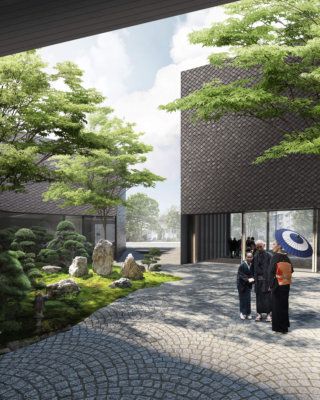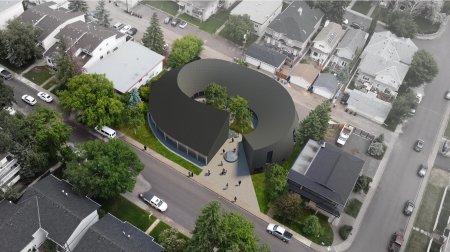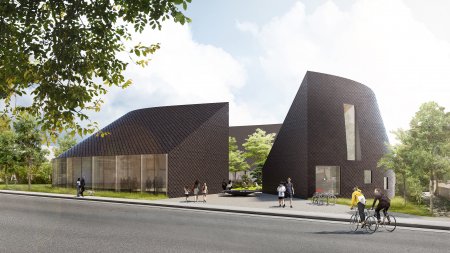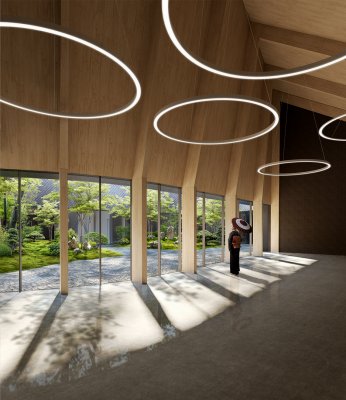Dr. Henry Tsang wins Canadian Architect Award of Excellence
Dr. Henry Tsang, in collaboration with Modern Office of Design + Architecture (MoDA), has won 2020’s Canadian Architect Award of Excellence for the Calgary Japanese Community Association.
Tsang joined Athabasca University (AU) in 2017, and is an assistant professor for RAIC Centre for Architecture. He spoke with us recently about the award and the inspiration for the design.
Athabasca University News
How did you and your collaborator, Modern Office of Design + Architecture, feel when you had found out you won the distinguished award?
We were thrilled!
Personally, this project is particularly meaningful to me. I spent ten years from 2002-2012 in Japan as a post-graduate student at the University of Tokyo, and as an architect in a design firm called Nihon Sekkei, so my connections with Japan are deep. My wife Yukari is also from Japan, so after moving to Calgary last year to work for AU, our family has been regular members of the Calgary Japanese Community Association (CJCA). Before the pandemic, we were there at least twice a week for Ikebana (flower arrangement) classes and dance practices, as we are part of a Yosakoi (traditional Japanese dance) troupe that performs at cultural events including the Calgary Stampede parade every year.
The current community centre is housed in a 70-year-old building, and there were major problems with deterioration, leakage, and the spaces were just not responding to the present needs of the membership. The president Roger Teshima asked me to investigate what they could do to optimize their assets as a feasibility study, that’s when I called up my friends at MoDA, for some advice on getting city zoning bylaws and maps to begin. This was back in the spring when everything was locked down due to COVID, and I was also on parental leave from AU. With our extra time “at home,” we decided to team up to take on this project and had some fun trying to totally re-imagine the CJCA.
So, this project is special in many ways, and we are just so excited that it’s getting so much attention and recognition.
Dr. Henry Tsang
Athabasca University News
What benefit can this bring back to the AU Community in general, and the RAIC Centre for Architecture in particular?
For AU, this is a great research opportunity. One of my research themes is Asian architecture and cities, and I am also interested in the cultural “fusion” of architecture in Canada as a result of immigration. Canada doesn’t have as strong a cultural and architectural identity as Europe or Asia, but we have imported a lot of architectural styles from other countries. Look around and you will find a mix of colonial styles, mixed with modern glass boxes, and then there are neighbourhoods like Chinatown and Little Italy… you see where I’m going. I’m fascinated by “fusion architecture,” a blend of flavours and ingredients from two worlds, and seeking to define this typology, through which a design process may emerge to carve a unique Canadian architectural identity.
This would inevitably lead us to revisit our country’s origins with architecture of the First Nations. My hope is that this project could be one that demonstrates the importance of culture, and lead to many more projects to question their identity. For AU, this would mean that there are some interesting research opportunities as well as possibilities to work and collaborate with local communities in Athabasca, Edmonton, Calgary, and Canada at large.
For the RAIC Centre for Architecture, this is definitely a huge win for myself and our department. The project has already been published in magazines and websites in Canada and overseas, so we are gaining some amazing attention and recognition.
As for student involvement, the project is still in the design development phase, so there is still a lot to do. I would love to get students involved. I’ve already presented the design scheme to students in my ADST architecture design studio courses, so many seem to be interested. The design for the building exterior uses “shou-sugi-ban,” a Japanese technique to char wood. Wouldn’t it be cool if we could get some AU students to volunteer in a building workshop to learn how to char wood?
Dr. Henry Tsang
Athabasca University News
Can you explain the cultural significance and inspiration for the design?
The design of the project is inspired by Japanese Zen principles of aesthetics, philosophy, and architecture, relating to nature, time, organization of spaces, and the balance of mass vs. voids. The traditional Japanese garden is the centerpiece of the project, so we had to make sure that the project experience feels authentically Japanese. I use the word “feel” because we were very careful not to imitate or create a replica of a Japanese building, but rather to design something that embraces Japanese architectural principles, while staying true to its Canadian roots and context by searching for forms and materials that integrate well in the low-key and quiet Killarney neighbourhood of Calgary. From the outside, it is a very tranquil building, while it is bustling with action inside.
We are also very proud of the form of the building. The curvaceous Möbius-like roof follows the sunpath to provide and control the natural lighting entering the building. This project uses passive solar design techniques, and will be a very “green” building—energy efficient with a low carbon footprint.
Dr. Henry Tsang
Athabasca University News
What was it about this project that you found to be the most rewarding?
What I find most rewarding is the opportunity to give back to the community a beautiful architecture, and to leave a legacy to future generations of Japanese-Canadians. My son Issey, who is nine months old, is a Japanese-Canadian dual citizen—our home’s utmost global citizen—and I can’t wait to show him the building and teach him about his roots. For Calgarians, I hope this place will become a magnificent gateway to Japanese culture.
Through my research, I’ve also learned and am still learning a lot about the history, heritage, and culture of the Nikkei (Japanese-Canadian) population, and their struggles to integrate in Canada. Recent movements against racism have also revived Canada’s history of discrimination against minorities, and the Nikkei were one of them. As an architect, I sometimes need to pretend to be a historian or an anthropologist to understand people and listen to their stories.
Dr. Henry Tsang
Athabasca University News
What were the biggest challenges encountered while designing the CJCA?
The project has been receiving very positive feedback from everyone so far, so it’s been going very smoothly. However, the biggest challenge starts now, as we haven’t secured the funding to build this project yet. The design team has been working on this project as volunteers, so our first step will be to look for grants, donations, and even kickstart a fundraising campaign. That said, even if the CJCA continues to use their current building, they will be wasting money on repairs, renovations and inefficient operational costs, so I do think it makes the most sense, from a sustainability perspective, to rebuild the centre from scratch.
So to answer your question: money is probably our biggest challenge and hurdle. Follow the project on the CJCA’s website. We welcome anyone who would like to help in any way or form.
Dr. Henry Tsang
Athabasca University News
How did you determine which materials were going to be used to create your design?
My philosophy with regards to materials is that they have to be regionally sourced, which makes sense from an embodied-carbon stance. For this project, we opted to use mass timber utilizing local woods as the building’s structure, and the building is wrapped in local red cedar cladding, treated with a “shou-sugi-ban” technique. Culturally, Japanese architecture also uses a lot of wood. Aesthetically, we just really like the warmth wood brings to the building.
Dr. Henry Tsang
Athabasca University News
Are there different design considerations that go into creating a multi-use space?
Yes. Designing a mixed-use building is like designing a miniature city. But it was important to us to create a building that would cater to a multi-generational demographic, starting from a daycare to senior housing. The membership of the CJCA is aging, so one of the main drivers of the project was to rejuvenate its membership to ensure the organization’s sustainability. As a result, users of the centre are diverse, and they all have different needs. So the spaces need to reflect that diversity, in the dimensions and shapes including accessibility and universal design, as well as in the materials, colors, etc. The great architect I.M. Pei once said: “Life is architecture and architecture is the mirror of life”.
Otherwise, city zoning rules also prescribe specific functions in building plots. Our first task was to make sure that the site allows us to combine the uses of a community centre with a daycare and a residential component.
Dr. Henry Tsang
Athabasca University News
Is there anything else you would like to share with us?
I just want to say kudos to the design team: Dustin Couzens & Ben Klumper at MoDA and Jim Madden at CREATE Projects. Thank you to our RAIC Centre for Architecture chair, Dr. Douglas MacLeod, and AU for supporting my research and design work. Thank you to our clients and friends at the Calgary Japanese Community Association for this opportunity, and to my wife, Yukari, and son, Issey, for inspiring me every day.
If anyone would like to learn more about the Calgary Japanese Community Centre project or the RAIC Centre for Architecture, please contact:
Dr. Henry Tsang
Assistant Professor
Athabasca University, RAIC Centre for Architecture
E-mail: htsang@athabascau.ca
Dr. Henry Tsang



